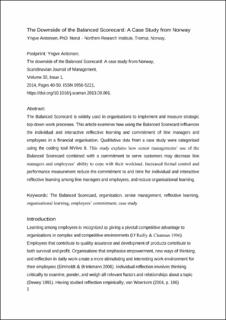The Downside of the Balanced Scorecard: A Case Study from Norway
| dc.contributor.author | Antonsen, Yngve | |
| dc.coverage.spatial | Norge | en_US |
| dc.date.accessioned | 2020-08-11T14:02:16Z | |
| dc.date.available | 2020-08-11T14:02:16Z | |
| dc.date.issued | 2014 | |
| dc.identifier.uri | https://hdl.handle.net/11250/2671522 | |
| dc.description.abstract | The Balanced Scorecard is widely used in organisations to implement and measure strategic top-down work processes. This article examines how using the Balanced Scorecard influences the individual and interactive reflective learning and commitment of line managers and employees in a financial organisation. Qualitative data from a case study were categorised using the coding tool NVivo 8. This study explains how senior managements’ use of the Balanced Scorecard combined with a commitment to serve customers may decrease line managers and employees’ ability to cope with their workload. Increased formal control and performance measurement reduce the commitment to and time for individual and interactive reflective learning among line managers and employees, and reduce organisational learning. | en_US |
| dc.language.iso | eng | en_US |
| dc.title | The Downside of the Balanced Scorecard: A Case Study from Norway | en_US |
| dc.type | Journal article | en_US |
| dc.identifier.doi | https://doi.org/10.1016/j.scaman.2013.08.001 | |
| dc.identifier.cristin | 1062275 | |
| dc.source.journal | Scandinavian Journal of Management | en_US |
| dc.source.volume | 30 | en_US |
| dc.source.issue | 1 | en_US |
| dc.source.pagenumber | 40-50 | en_US |
| dc.subject.nsi | Samfunnsvitenskap | en_US |
